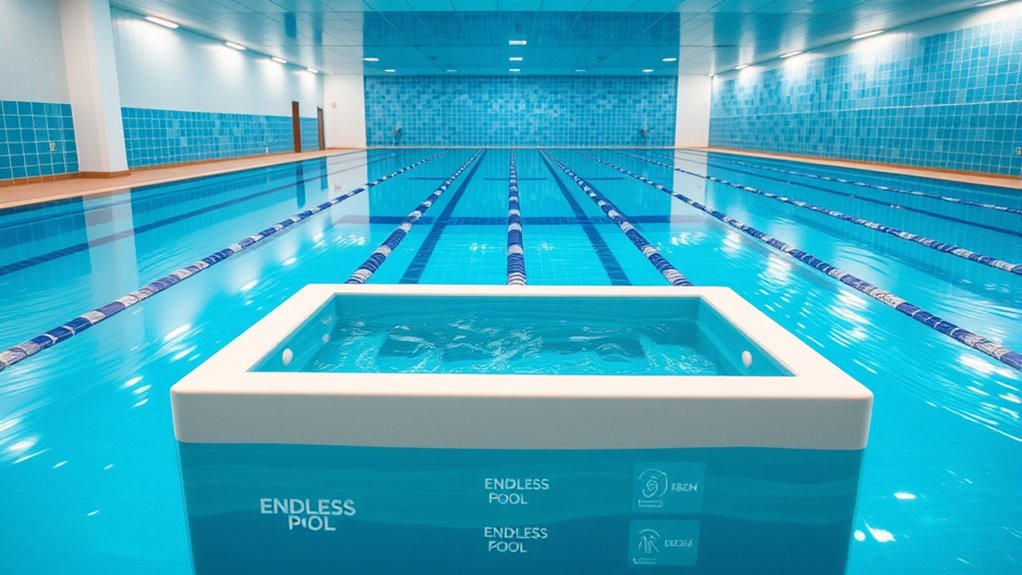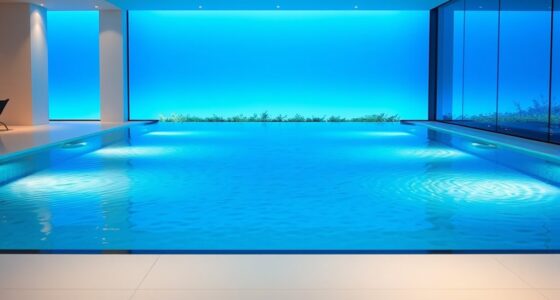Choosing between an endless pool and traditional swimming depends on your fitness goals and lifestyle. An endless pool offers convenient, low-impact workouts with customizable resistance, making it ideal for tailored cardio and strength routines while protecting your joints. Traditional swimming provides outdoor connection and a broader community experience but requires more space and maintenance. Whichever you choose, understanding their benefits can help you stick with your wellness journey—learn more to maximize your results.
Key Takeaways
- Endless pools offer customizable resistance and workout modes, enabling targeted strength, endurance, and interval training at home.
- Traditional swimming utilizes natural water resistance and body weight, promoting full-body muscle development and cardiovascular health.
- Both options provide low-impact, joint-friendly exercise environments that reduce injury risk and support joint longevity.
- Endless pools allow year-round, convenient workouts with safety features, while traditional pools foster outdoor activity and community engagement.
- Long-term benefits include improved cardiovascular health, muscular endurance, weight management, and mental clarity, achieved through consistent use of either method.
Cardiovascular Conditioning and Endurance
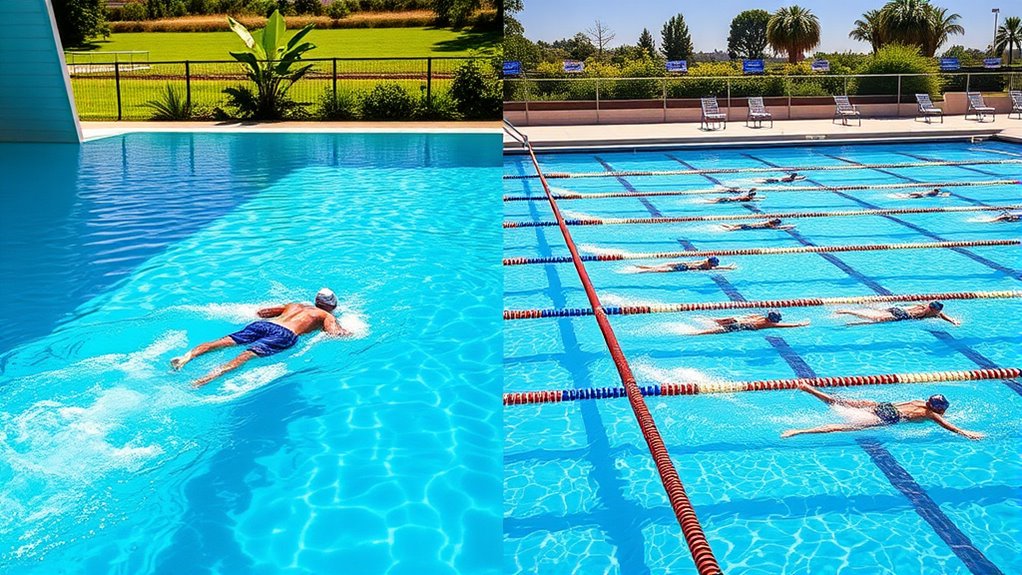
Improving your cardiovascular conditioning and endurance can markedly boost your overall health and energy levels. When you focus on activities like swimming, you strengthen your heart and lungs, making everyday tasks easier. As your stamina increases, you’ll notice better circulation, lower blood pressure, and reduced risk of heart disease. Consistent aerobic exercise also helps regulate weight and improves mental clarity. By pushing your limits gradually, you build resilience against fatigue and enhance your body’s ability to recover. Swimming, whether in an endless pool or traditional pool, provides a low-impact way to elevate your heart rate, making it easier to sustain longer workouts. Additionally, the low-impact nature of swimming reduces stress on your joints, allowing for longer and more frequent exercise sessions. Over time, this leads to a healthier, more energized you, ready to take on daily challenges with vigor.
Muscle Toning and Strength Development
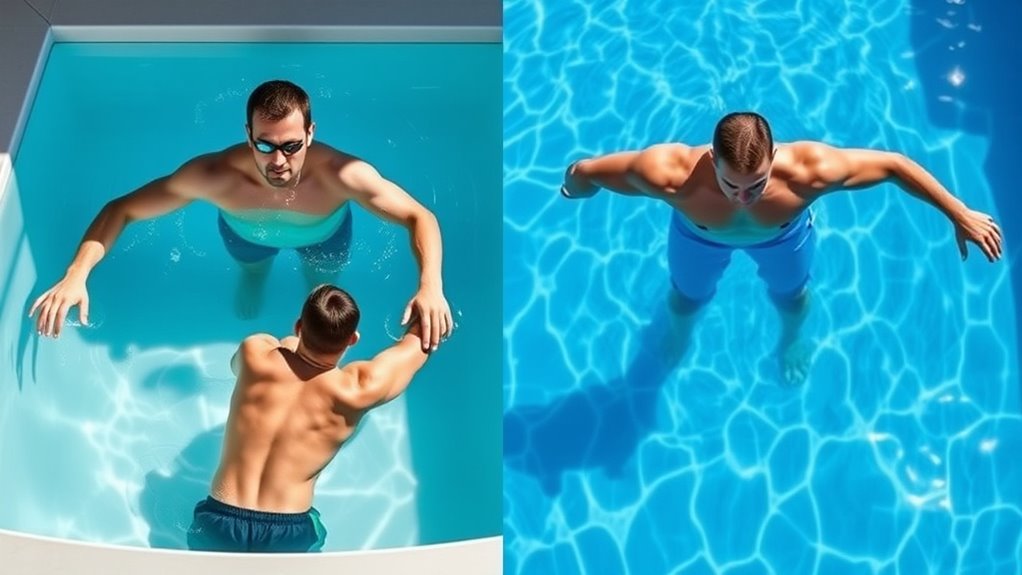
To build muscle tone and strength, incorporating resistance exercises into your routine is essential. Swimming naturally engages multiple muscle groups, but the type of equipment you use influences muscle development. Endless pools offer adjustable resistance, allowing for targeted strength training. Traditional swimming often relies on body weight and water resistance, promoting overall muscle endurance. To maximize muscle toning, consider different approaches:
| Method | Focus Area | Equipment Needed |
|---|---|---|
| Resistance training | Upper body, core | Resistance bands, weights |
| Interval swimming | Full-body strength | Pool, kickboard |
| Specific exercises | Muscle isolation | Dumbbells, paddles |
Incorporating these strategies helps you develop strength effectively, whether in an endless pool or traditional setting. Properly calibrated projectors can also enhance visual clarity, supporting your motivation and focus during workouts.
Impact on Joint Health and Injury Prevention

Regular, low-impact exercises can considerably reduce stress on your joints, helping them stay healthy longer. This also lowers your chances of injuries during workouts or daily activities. By choosing the right activities, you protect your joints while staying active and strong. Incorporating gentle exercise options like swimming or using an endless pool can further enhance joint health by providing a smooth, supportive environment for movement.
Reduced Impact on Joints
Because high-impact exercises can strain your joints and increase the risk of injury, choosing low-impact activities offers a safer alternative for maintaining fitness. Swimming in an Endless Pool or traditional pool minimizes joint stress by supporting your body weight, reducing pressure on knees, hips, and ankles. Unlike high-impact workouts, water’s buoyancy helps cushion your joints during movement, decreasing wear and tear. This gentler approach makes it easier to sustain regular exercise without pain or discomfort, especially if you have existing joint issues or are recovering from injury. Both Endless Pools and traditional pools provide a smooth, supportive environment that encourages consistent activity while protecting your joints. As a result, you can focus on improving strength and endurance without worrying about joint strain. Incorporating low-impact exercises like swimming can also help improve overall joint health and flexibility over time.
Lower Injury Risks
Engaging in low-impact exercises substantially reduces your risk of joint injuries, making them a safer choice for long-term health. Both endless pools and traditional swimming offer gentle workouts that minimize stress on your joints. However, endless pools provide controlled environments, reducing the chance of accidental injuries like slips or overexertion. To understand injury risks better, consider this comparison:
| Feature | Traditional Pool |
|---|---|
| Surface and environment | Variable, sometimes slippery |
| Supervision and control | Less consistent, more hazards |
| Injury risk factors | Overexertion, slips |
| Injury prevention benefits | Controlled, consistent conditions |
Choosing the right setup helps you stay injury-free and sustain your fitness journey longer. Additionally, the controlled environment of an endless pool can facilitate regular exercise, which is essential for maintaining overall health and preventing injuries.
Convenience and Accessibility of Workouts
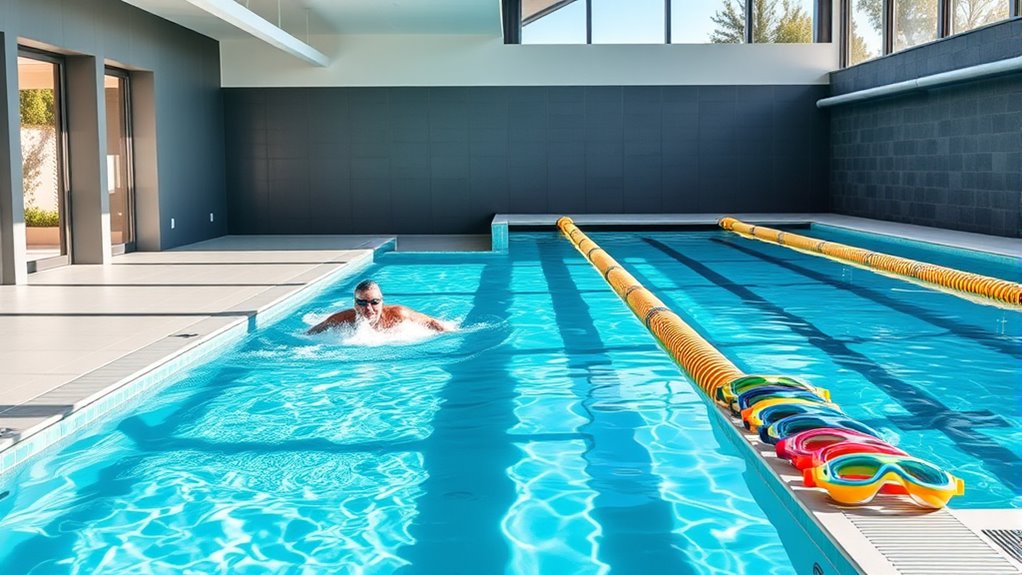
The convenience and accessibility of workouts have considerably increased with the rise of digital fitness options. With an Endless Pool, you can swim whenever it suits your schedule without worrying about gym hours or weather conditions. It’s installed right in your home, so you don’t need to commute or wait for lane availability. This setup makes it easier to fit workouts into busy days and stay consistent. Traditional swimming requires access to a pool, which might be limited by location, opening hours, or membership restrictions. An Endless Pool eliminates these barriers, giving you 24/7 access. Whether you prefer early mornings or late nights, you have the flexibility to work out at your convenience. This level of accessibility helps you maintain a regular fitness routine without added hassle. Additionally, digital fitness technology continues to evolve, offering new tools and features that enhance your workout experience indoors.
Customization and Variety of Exercises
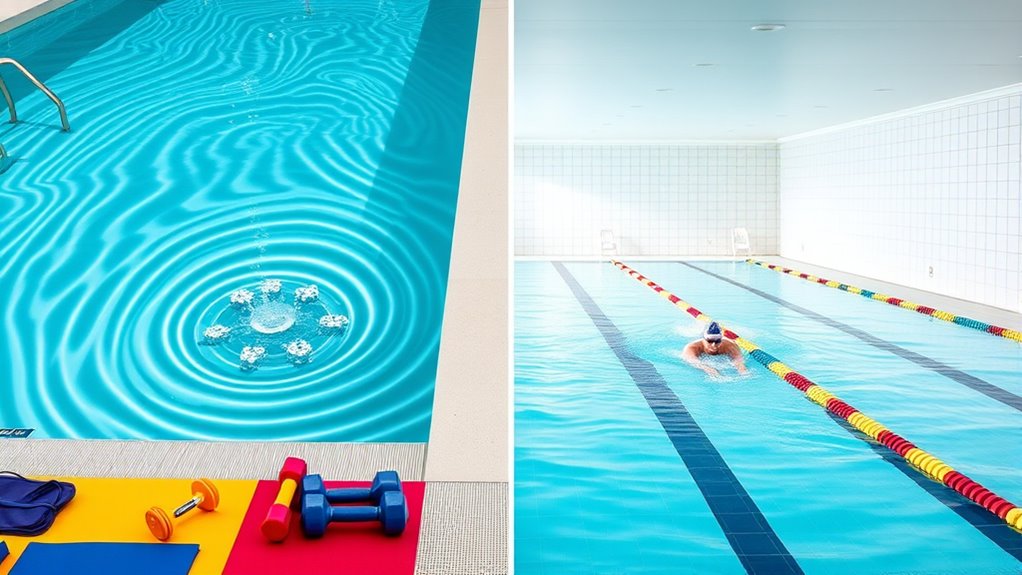
One of the key advantages of an Endless Pool is the ability to customize your workout and choose from a wide variety of exercises. You can adjust water current speeds for sprints or steady swimming, switch between different workout modes, and incorporate resistance jets for strength training. This flexibility allows you to target specific muscle groups and vary your routines easily. Here’s a quick look at some exercise options:
| Exercise Type | Focus Area | Equipment Needed |
|---|---|---|
| Interval Training | Cardiovascular health | Adjustable current |
| Resistance Training | Strength building | Resistance jets |
| Technique Drills | Form and efficiency | Swim mirrors or guides |
| Water Aerobics | Low-impact cardio | Optional accessories |
This variety keeps your workouts engaging and tailored to your fitness goals. Additionally, incorporating customization in your exercise routines can help optimize results and keep motivation high.
Space Requirements and Setup Costs
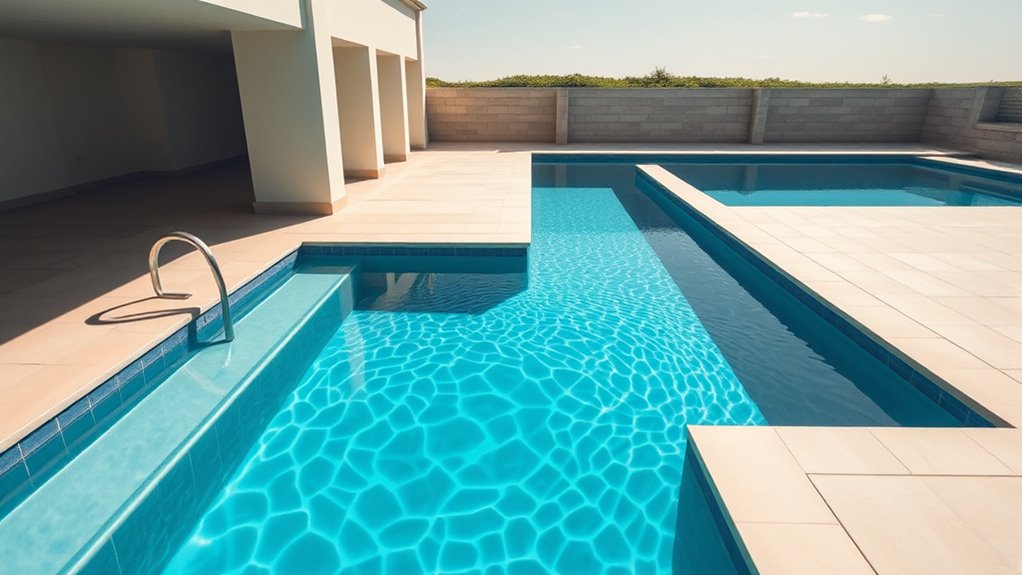
Setting up an Endless Pool requires careful consideration of space and budget. Unlike traditional swimming pools, these compact units fit into smaller areas, often fitting into a garage, basement, or backyard patio. You’ll need a flat, level surface with enough clearance around the pool for safe entry, exit, and maintenance. The setup costs vary depending on size, features, and installation complexity, typically ranging from $15,000 to $30,000. Additional expenses include site preparation, electrical wiring, and possible structural modifications. While the initial investment might seem high, the compact design can save you money on land and construction. Keep in mind, choosing the right location guarantees safety, convenience, and maximum use of your space. Proper planning can also help prevent potential nutrient deficiencies that might occur with improper setup or maintenance.
Maintenance and Operational Considerations
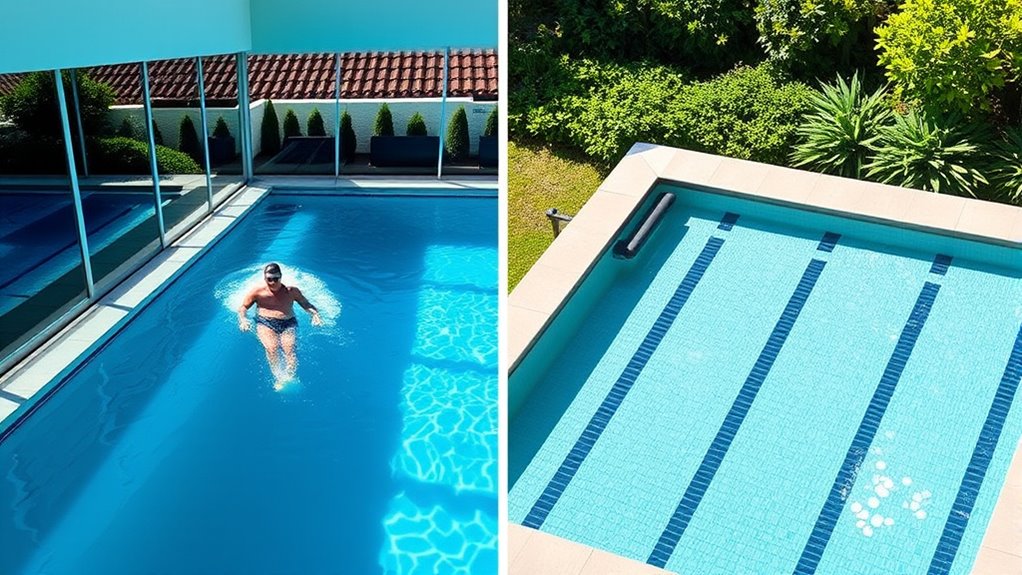
When considering fitness equipment, it’s important to think about how much it costs to keep everything running smoothly and how easy it is to use daily. You’ll want options that don’t require constant maintenance or complicated setup, so your routine stays consistent. Focusing on simplicity and affordability helps make certain your fitness setup remains effective and hassle-free. Additionally, selecting equipment with transparent policies ensures you are well-informed about data collection and privacy practices.
Cost and Upkeep
Have you ever considered how much ongoing maintenance and operational costs can impact your fitness investment? Both Endless Pools and traditional pools require regular expenses, but they differ in scope.
- Initial investment: Endless Pools tend to be less expensive upfront, but quality varies. Traditional pools usually cost more initially due to size and installation.
- Energy consumption: Endless Pools often use less energy, saving you money on electricity. Traditional pools, with larger pumps and heaters, can hike your utility bills.
- Maintenance tasks: Regular cleaning, chemical balancing, and equipment upkeep are necessary for both, but traditional pools demand more extensive upkeep, increasing costs over time. Additionally, pool maintenance techniques can significantly influence long-term expenses.
Understanding these costs helps you plan your budget and make an informed choice aligned with your fitness goals.
Ease of Use
While costs are a key factor, how easy a pool is to operate and maintain can substantially influence your overall experience. An Endless Pool is designed for convenience, with simple controls and minimal setup, making daily use straightforward. Its self-cleaning features reduce maintenance time, and the compact size means less space and fewer parts to service. Traditional pools, on the other hand, often require more effort: regular chemical balancing, filter cleaning, and equipment checks can be time-consuming. Operating a traditional pool typically demands more knowledge and ongoing attention. If you prefer a hassle-free experience with minimal upkeep, an Endless Pool offers a clear advantage. However, if you’re comfortable managing larger systems and routine maintenance, a traditional pool might still suit your needs.
Safety and Usability Features
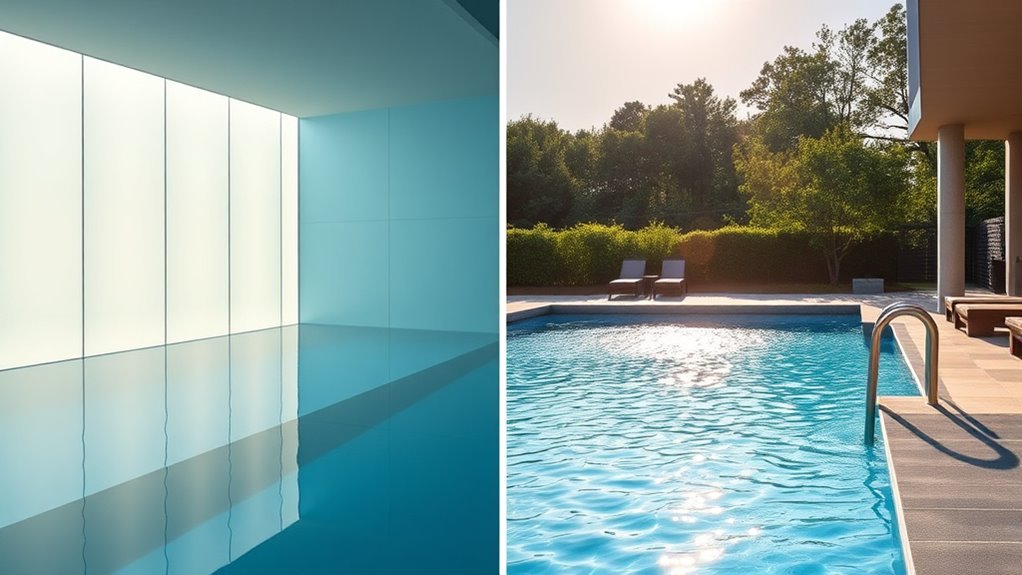
Safety and usability features are essential to guarantee your workout experience is both effective and secure. With proper safety measures, you can focus on your fitness goals without worry. Endless pools and traditional pools offer different features to enhance safety:
Prioritizing safety features ensures effective, worry-free workouts with endless or traditional pools.
- Automatic shut-off systems that prevent overheating or malfunction.
- Non-slip surfaces around the pool to reduce slips and falls.
- Easy-to-use controls with clear displays for quick adjustments during your swim.
Endless pools often include built-in safety sensors and minimal maintenance components, making them user-friendly. Traditional pools may require additional safety equipment like barriers or alarms. Prioritizing these features assures your workouts remain safe, enjoyable, and accessible.
Long-term Wellness and Lifestyle Integration

Incorporating safety and usability features into your workout routine sets the foundation for a sustainable fitness lifestyle. When you choose between an Endless Pool or traditional swimming, consider how each fits into your long-term wellness goals. An Endless Pool offers convenience, allowing you to swim regularly regardless of weather or time constraints, making consistent exercise easier to maintain. Traditional swimming might require more planning but can deepen your connection to outdoor environments and community pools, enriching your routine. To integrate these options into your lifestyle, set realistic goals and create a schedule that fits your daily rhythm. Prioritize enjoyment and variety to stay motivated. Over time, these habits promote lasting health benefits and make fitness a seamless, integral part of your everyday life.
Frequently Asked Questions
How Does Water Temperature Affect Workout Effectiveness in Both Pools?
Water temperature directly impacts your workout effectiveness by influencing your comfort, endurance, and recovery. Warmer water (around 78-82°F) helps you relax muscles and extend exercise duration, while cooler water (around 76°F or lower) boosts alertness and fat burning. In both pools, maintaining a suitable temperature guarantees you stay comfortable, prevent overheating, and maximize performance. Adjust the water temperature based on your goals to get the most out of each swim session.
Can an Endless Pool Simulate Open-Water Swimming Conditions Accurately?
You’ll find that an endless pool can come surprisingly close to mimicking open-water conditions, especially with adjustable current speeds and water temperatures. While it doesn’t perfectly replicate waves and natural currents, it offers a controlled environment that challenges your endurance and technique much like open water. This makes it a great option for training year-round, helping you stay prepared without the unpredictability of outdoor swimming.
What Are the Energy Consumption Differences Between Traditional Pools and Endless Pools?
Endless pools typically consume less energy than traditional pools because they use smaller pumps and heaters, focusing on maintaining a controlled current rather than large volumes of water. Traditional pools, especially outdoor ones, require more energy for filtration, heating, and circulation. If you’re looking to save on energy costs, an endless pool offers a more efficient option, reducing power usage while still providing effective swimming workouts.
How Do Maintenance Routines Differ for Traditional Pools Versus Endless Pools?
Maintaining a traditional pool is like tending a garden—you need to regularly check chemical levels, clean filters, and manage water balance, which can be time-consuming. Endless pools require less upkeep because they’re smaller, have fewer filters, and use advanced systems that simplify chemical adjustments. You’ll spend less time and effort, making maintenance feel like a breeze instead of a storm. Overall, endless pools offer a more streamlined, hassle-free routine.
Are There Specific Safety Certifications for Endless Pools Compared to Traditional Pools?
You’ll find that endless pools often have specific safety certifications, like UL or ETL approvals, ensuring electrical and structural safety. Traditional pools may also have certifications, but they typically focus on barriers and water quality standards. Always check for manufacturer-provided safety certifications and local codes for both types. These certifications help you confirm that the pool meets safety standards, giving you peace of mind during your workouts or relaxation.
Conclusion
Choosing between an endless pool and traditional swimming is like finding the perfect dance partner—each offers unique benefits. An endless pool provides convenience, customization, and year-round usability, making fitness seamless. Traditional swimming, however, delivers a classic, full-body workout in open water. Consider your space, goals, and lifestyle. Whichever you pick, staying active is your best move—like a steady beat guiding you toward better health and wellness every day.
